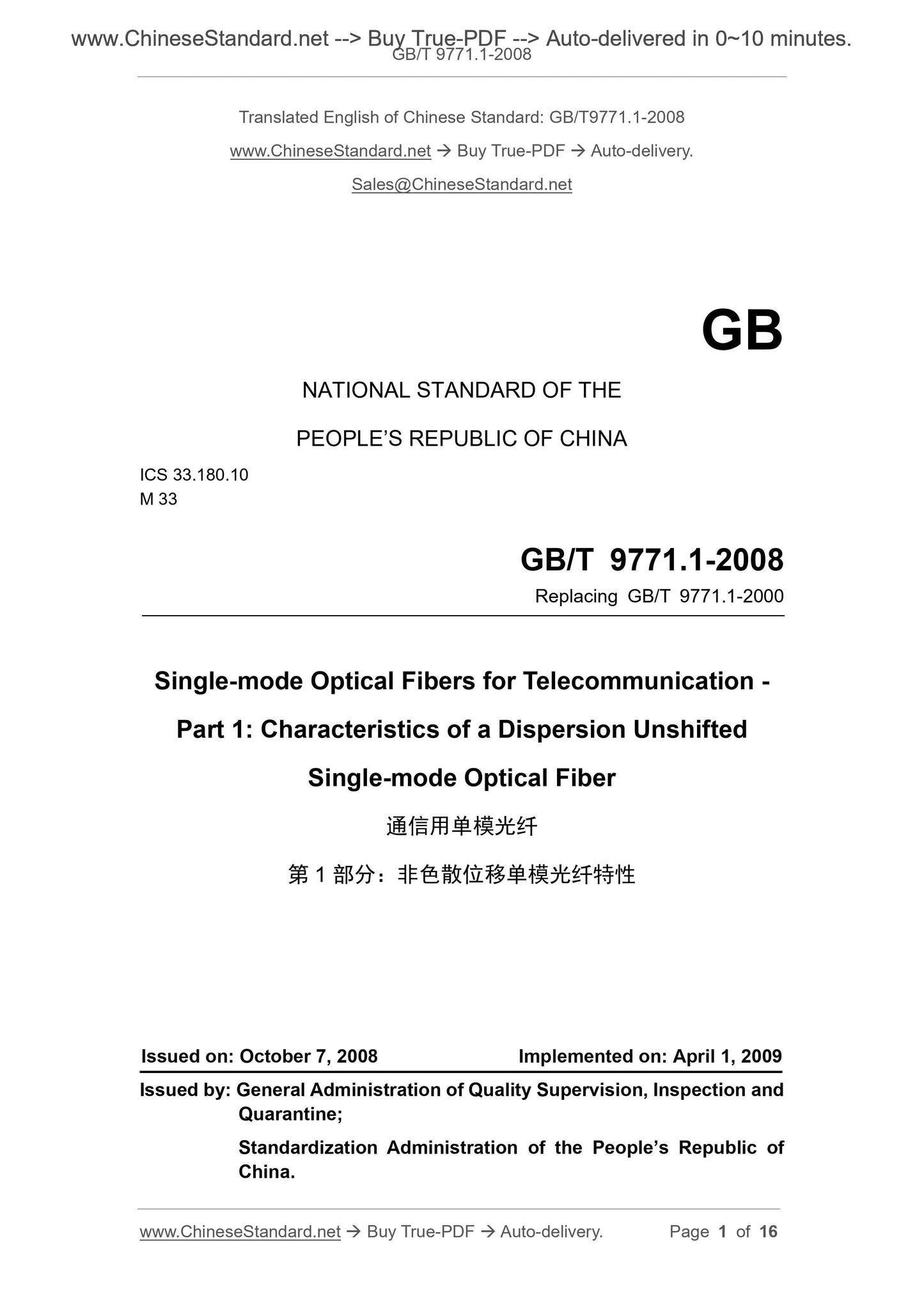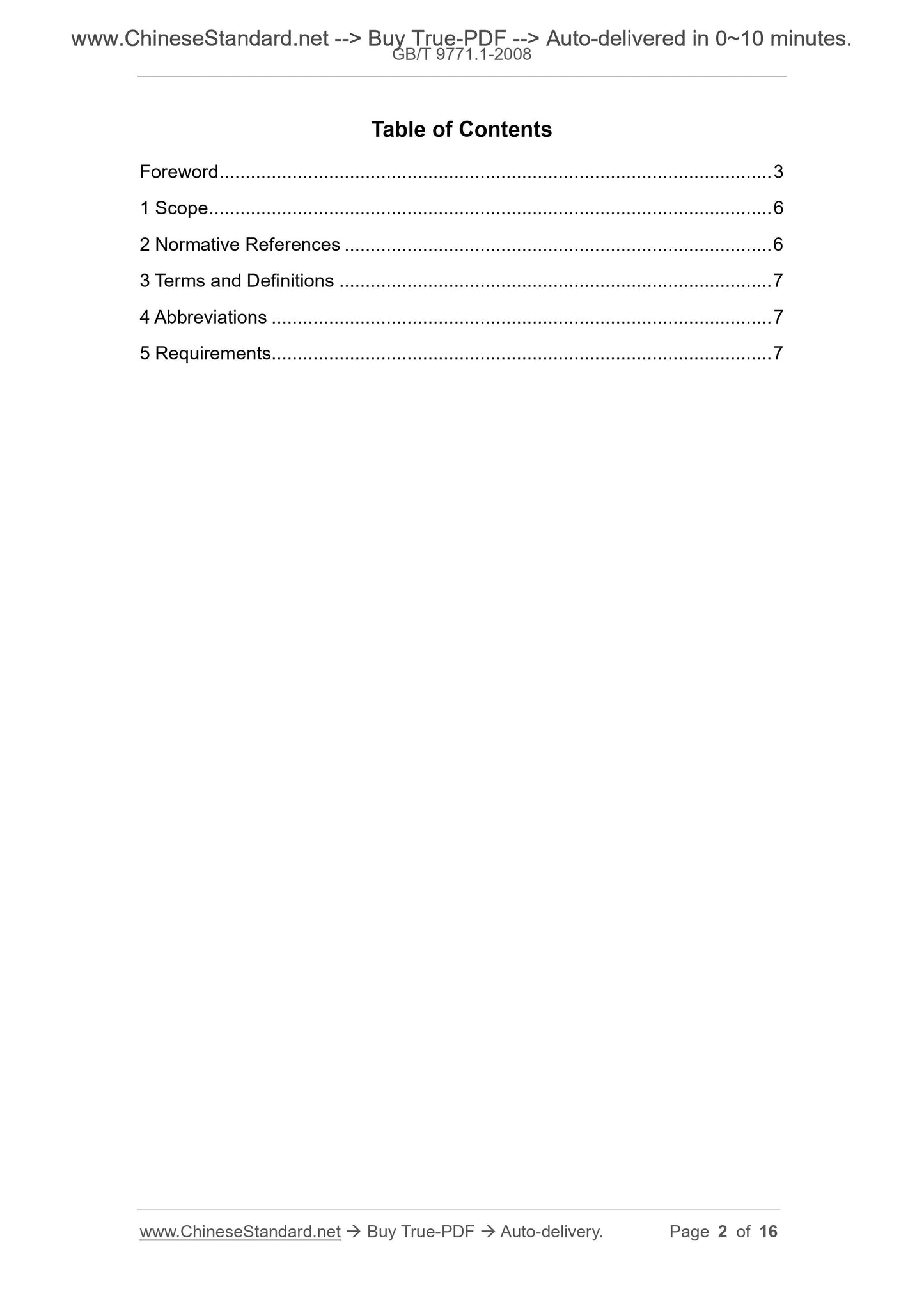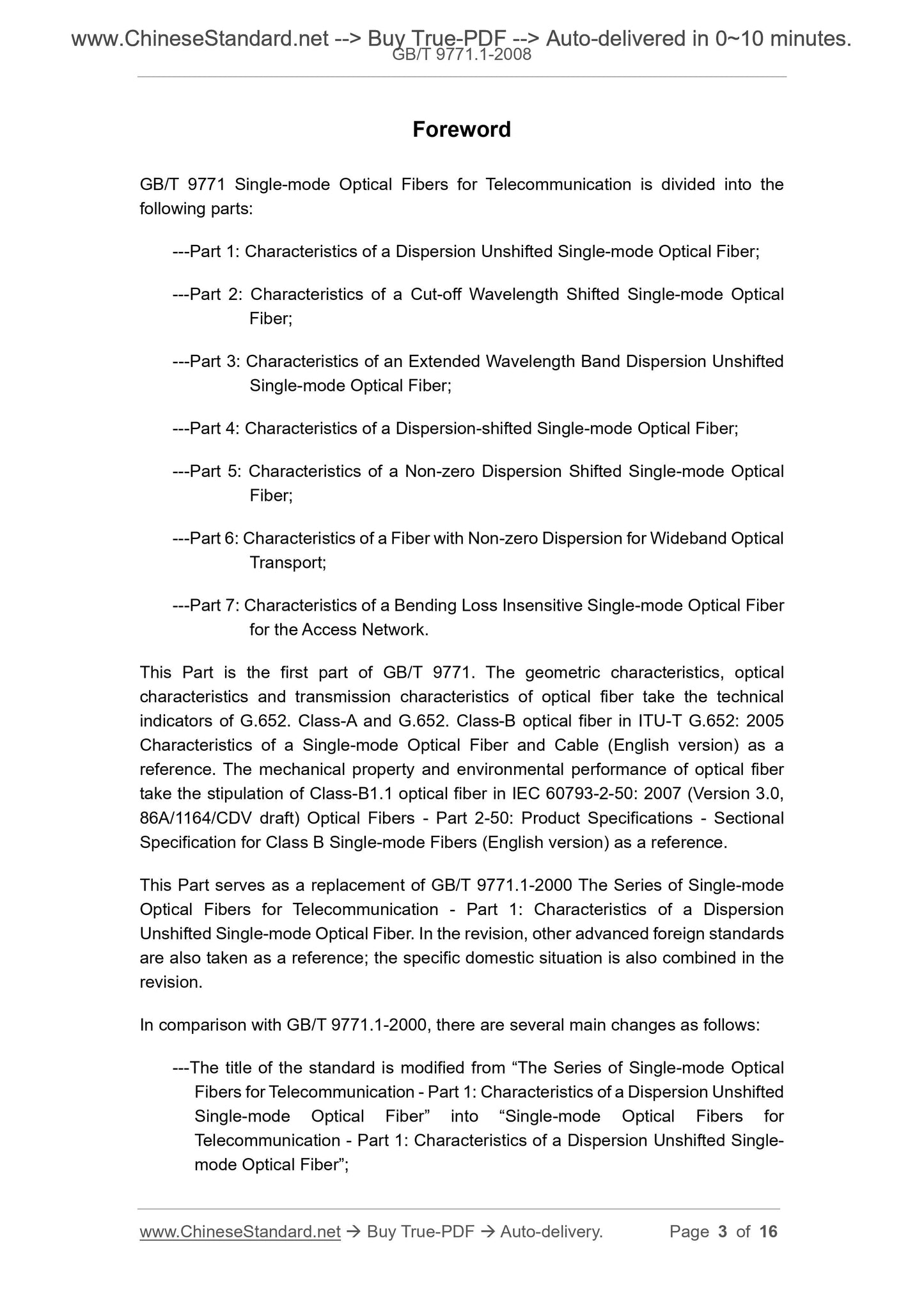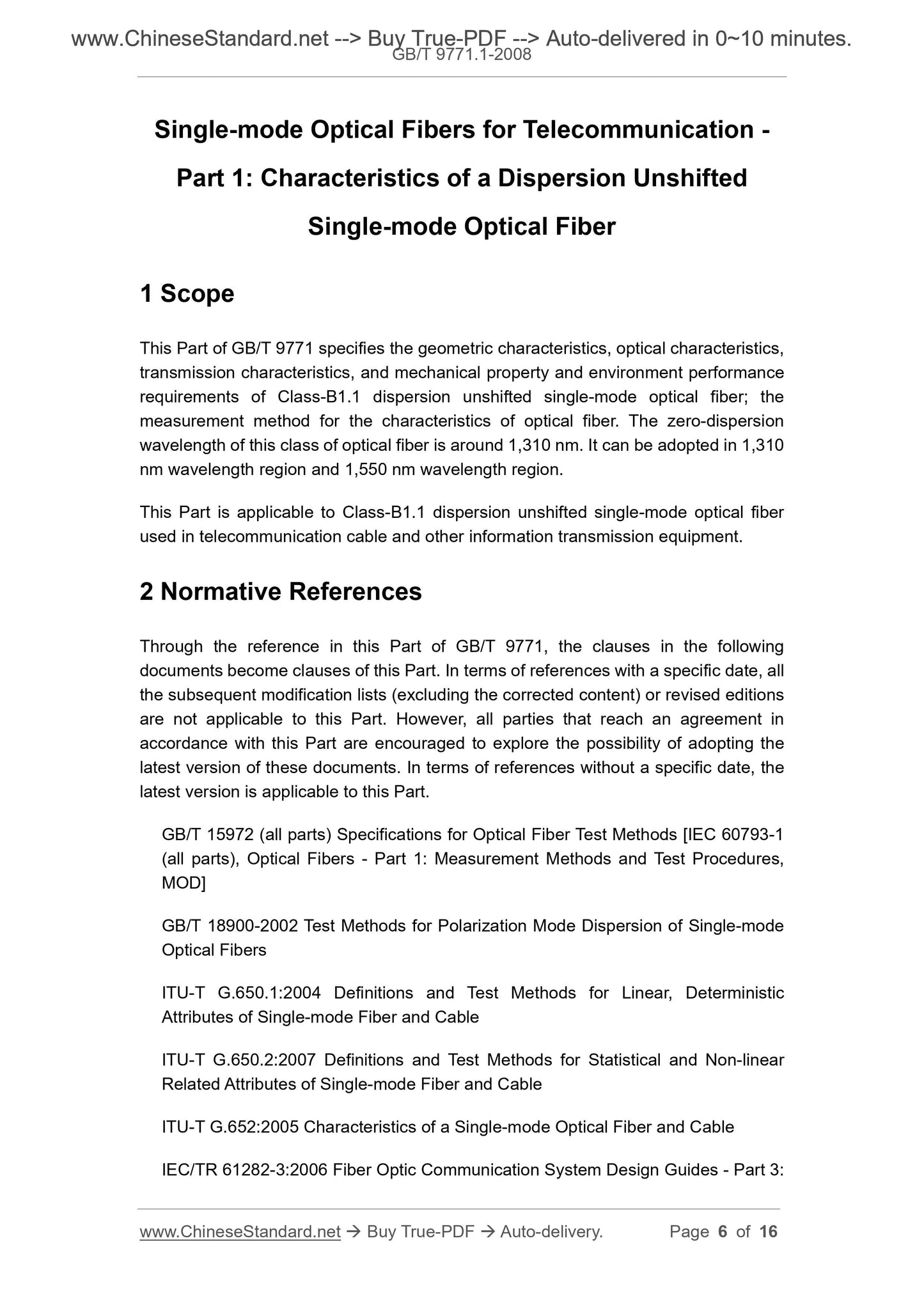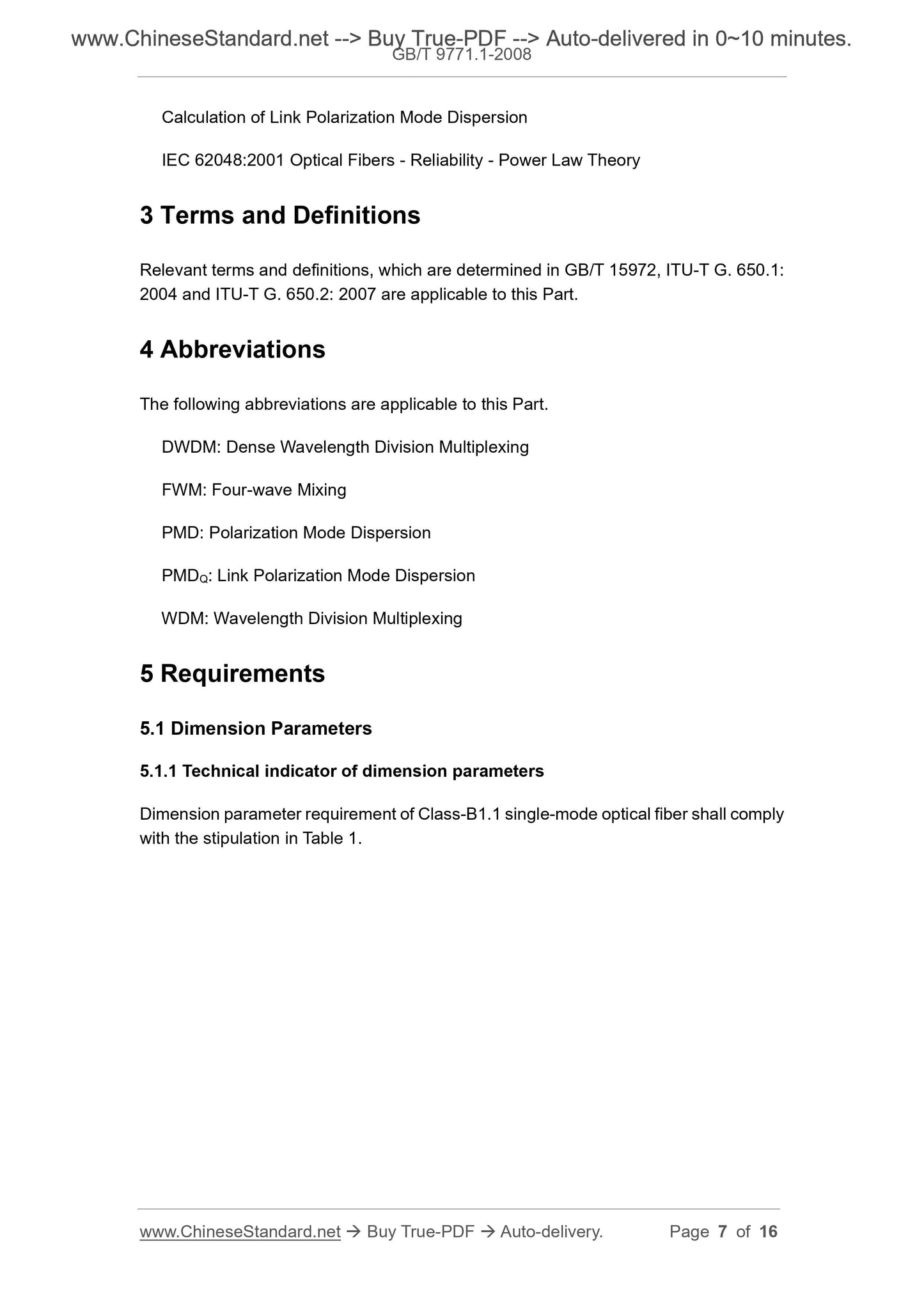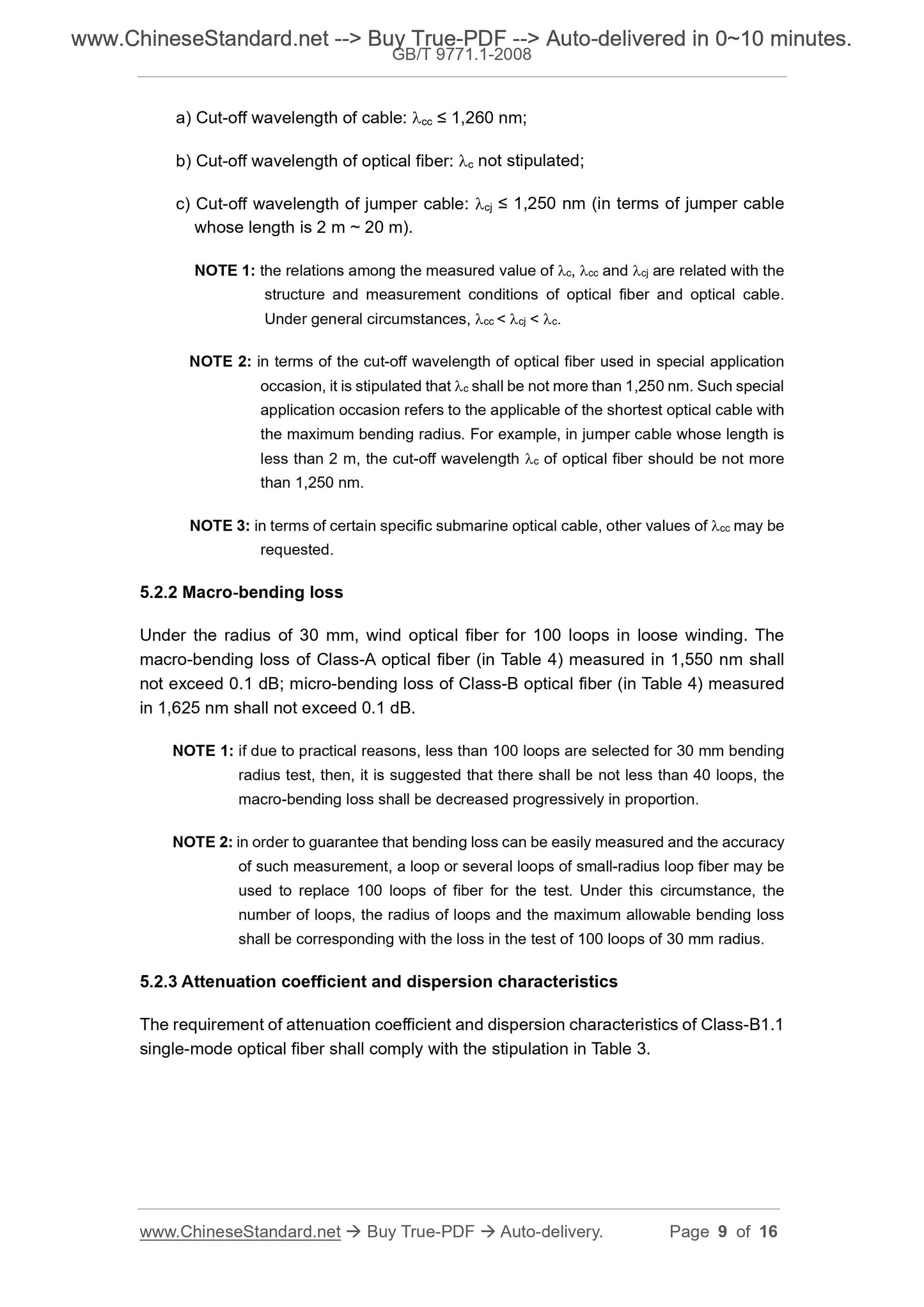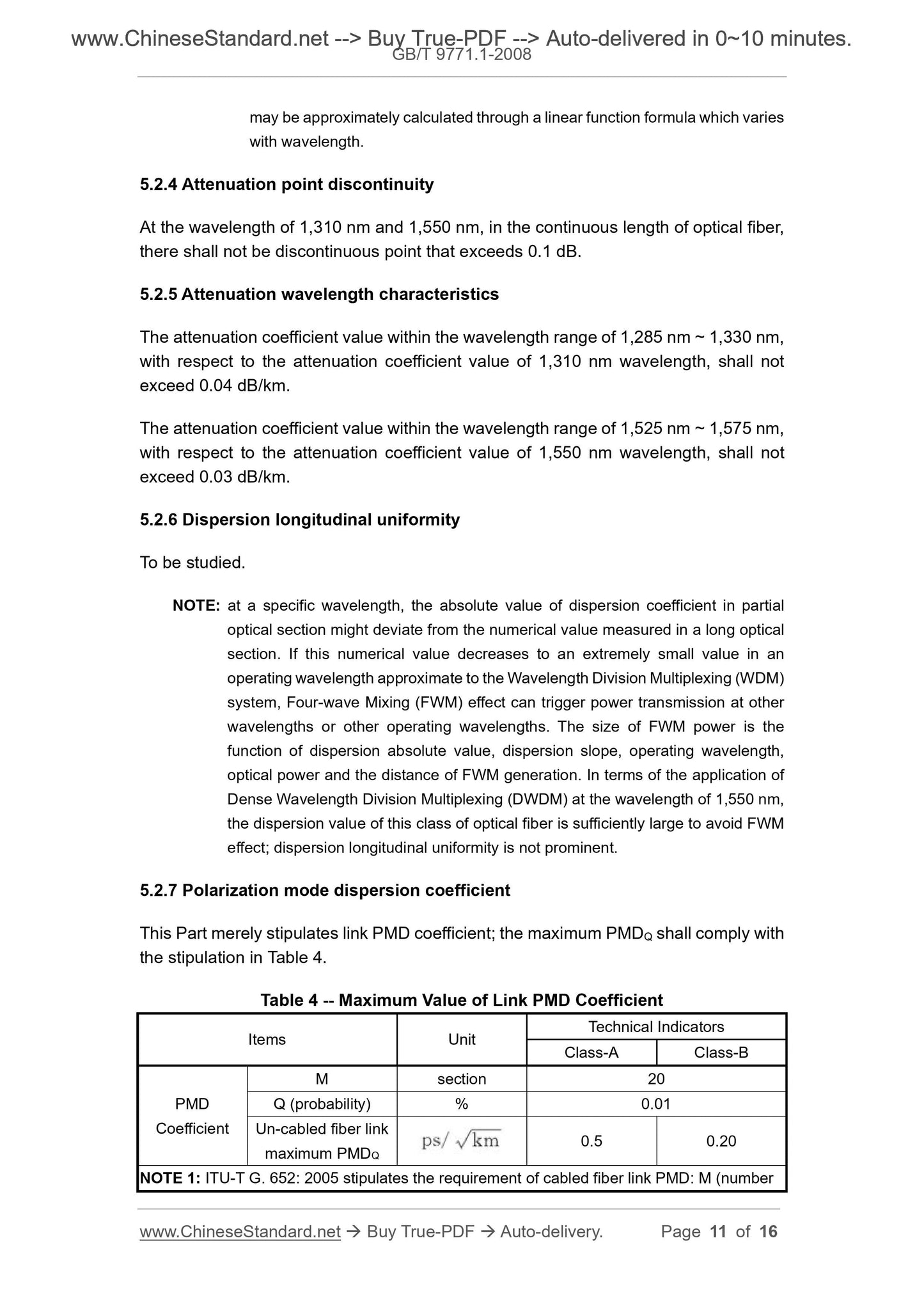1
/
of
7
PayPal, credit cards. Download editable-PDF and invoice in 1 second!
GB/T 9771.1-2008 English PDF (GBT9771.1-2008)
GB/T 9771.1-2008 English PDF (GBT9771.1-2008)
Regular price
$150.00 USD
Regular price
Sale price
$150.00 USD
Unit price
/
per
Shipping calculated at checkout.
Couldn't load pickup availability
Delivery: 3 seconds. Download true-PDF + Invoice.
Get QUOTATION in 1-minute: Click GB/T 9771.1-2008
Historical versions: GB/T 9771.1-2008
Preview True-PDF (Reload/Scroll if blank)
GB/T 9771.1-2008: Single-mode optical fibres for telecommunication -- Part 1: Characteristics of a dispersion unshifted single-mode optical fibre
GB/T 9771.1-2008
GB
NATIONAL STANDARD OF THE
PEOPLE’S REPUBLIC OF CHINA
ICS 33.180.10
M 33
Replacing GB/T 9771.1-2000
Single-mode Optical Fibers for Telecommunication -
Part 1. Characteristics of a Dispersion Unshifted
Single-mode Optical Fiber
ISSUED ON. OCTOBER 7, 2008
IMPLEMENTED ON. APRIL 1, 2009
Issued by. General Administration of Quality Supervision, Inspection and
Quarantine;
Standardization Administration of the People’s Republic of
China.
Table of Contents
Foreword ... 3
1 Scope ... 6
2 Normative References ... 6
3 Terms and Definitions ... 7
4 Abbreviations ... 7
5 Requirements... 7
Foreword
GB/T 9771 Single-mode Optical Fibers for Telecommunication is divided into the
following parts.
---Part 1. Characteristics of a Dispersion Unshifted Single-mode Optical Fiber;
---Part 2. Characteristics of a Cut-off Wavelength Shifted Single-mode Optical
Fiber;
---Part 3. Characteristics of an Extended Wavelength Band Dispersion Unshifted
Single-mode Optical Fiber;
---Part 4. Characteristics of a Dispersion-shifted Single-mode Optical Fiber;
---Part 5. Characteristics of a Non-zero Dispersion Shifted Single-mode Optical
Fiber;
---Part 6. Characteristics of a Fiber with Non-zero Dispersion for Wideband Optical
Transport;
---Part 7. Characteristics of a Bending Loss Insensitive Single-mode Optical Fiber
for the Access Network.
This Part is the first part of GB/T 9771. The geometric characteristics, optical
characteristics and transmission characteristics of optical fiber take the technical
indicators of G.652. Class-A and G.652. Class-B optical fiber in ITU-T G.652. 2005
Characteristics of a Single-mode Optical Fiber and Cable (English version) as a
reference. The mechanical property and environmental performance of optical fiber
take the stipulation of Class-B1.1 optical fiber in IEC 60793-2-50. 2007 (Version 3.0,
86A/1164/CDV draft) Optical Fibers - Part 2-50. Product Specifications - Sectional
Specification for Class B Single-mode Fibers (English version) as a reference.
This Part serves as a replacement of GB/T 9771.1-2000 The Series of Single-mode
Optical Fibers for Telecommunication - Part 1. Characteristics of a Dispersion
Unshifted Single-mode Optical Fiber. In the revision, other advanced foreign standards
are also taken as a reference; the specific domestic situation is also combined in the
revision.
In comparison with GB/T 9771.1-2000, there are several main changes as follows.
---The title of the standard is modified from “The Series of Single-mode Optical
Fibers for Telecommunication - Part 1. Characteristics of a Dispersion Unshifted
Single-mode Optical Fiber” into “Single-mode Optical Fibers for
Telecommunication - Part 1. Characteristics of a Dispersion Unshifted Single-
mode Optical Fiber”;
Single-mode Optical Fibers for Telecommunication -
Part 1. Characteristics of a Dispersion Unshifted
Single-mode Optical Fiber
1 Scope
This Part of GB/T 9771 specifies the geometric characteristics, optical characteristics,
transmission characteristics, and mechanical property and environment performance
requirements of Class-B1.1 dispersion unshifted single-mode optical fiber; the
measurement method for the characteristics of optical fiber. The zero-dispersion
wavelength of this class of optical fiber is around 1,310 nm. It can be adopted in 1,310
nm wavelength region and 1,550 nm wavelength region.
This Part is applicable to Class-B1.1 dispersion unshifted single-mode optical fiber
used in telecommunication cable and other information transmission equipment.
2 Normative References
Through the reference in this Part of GB/T 9771, the clauses in the following
documents become clauses of this Part. In terms of references with a specific date, all
the subsequent modification lists (excluding the corrected content) or revised editions
are not applicable to this Part. However, all parties that reach an agreement in
accordance with this Part are encouraged to explore the possibility of adopting the
latest version of these documents. In terms of references without a specific date, the
latest version is applicable to this Part.
GB/T 15972 (all parts) Specifications for Optical Fiber Test Methods [IEC 60793-1
(all parts), Optical Fibers - Part 1. Measurement Methods and Test Procedures,
MOD]
GB/T 18900-2002 Test Methods for Polarization Mode Dispersion of Single-mode
Optical Fibers
ITU-T G.650.1.2004 Definitions and Test Methods for Linear, Deterministic
Attributes of Single-mode Fiber and Cable
ITU-T G.650.2.2007 Definitions and Test Methods for Statistical and Non-linear
Related Attributes of Single-mode Fiber and Cable
ITU-T G.652.2005 Characteristics of a Single-mode Optical Fiber and Cable
IEC/TR 61282-3.2006 Fiber Optic Communication System Design Guides - Part 3.
Calculation of Link Polarization Mode Dispersion
IEC 62048.2001 Optical Fibers - Reliability - Power Law Theory
3 Terms and Definitions
Relevant terms and definitions, which are determined in GB/T 15972, ITU-T G. 650.1.
2004 and ITU-T G. 650.2. 2007 are applicable to this Part.
4 Abbreviations
The following abbreviations are applicable to this Part.
DWDM. Dense Wavelength Division Multiplexing
FWM. Four-wave Mixing
PMD. Polarization Mode Dispersion
PMDQ. Link Polarization Mode Dispersion
WDM. Wavelength Division Multiplexing
5 Requirements
5.1 Dimension Parameters
5.1.1 Technical indicator of dimension parameters
Dimension parameter requirement of Class-B1.1 single-mode optical fiber shall comply
with the stipulation in Table 1.
a) Cut-off wavelength of cable. cc ≤ 1,260 nm;
b) Cut-off wavelength of optical fiber. c not stipulated;
c) Cut-off wavelength of jumper cable. cj ≤ 1,250 nm (in terms of jumper cable
whose length is 2 m ~ 20 m).
NOTE 1. the relations among the measured value of c, cc and cj are related with the
structure and measurement conditions of optical fiber and optical cable.
Under general circumstances, cc < cj < c.
NOTE 2. in terms of the cut-off wavelength of optical fiber used in special application
occasion, it is stipulated that c shall be not more than 1,250 nm. Such special
application occasion refers to the applicable of the shortest optical cable with
the maximum bending radius. For example, in jumper cable whose length is
less than 2 m, the cut-off wavelength c of optical fiber should be not more
than 1,250 nm.
NOTE 3. in terms of certain specific submarine optical cable, other values of cc may be
requested.
5.2.2 Macro-bending loss
Under the radius of 30 mm, wind optical fiber for 100 loops in loose winding. The
macro-bending loss of Class-A optical fiber (in Table 4) measured in 1,550 nm shall
not exceed 0.1 dB; micro-bending loss of Class-B optical fiber (in Table 4) measured
in 1,625 nm shall not exceed 0.1 dB.
NOTE 1. if due to practical reasons, less than 100 loops are selected for 30 mm bending
radius test, then, it is suggested that there shall be not less than 40 loops, the
macro-bending loss shall be decreased progressively in proportion.
NOTE 2. in order to guarantee that bending loss can be easily measured and the accuracy
of such measurement, a loop or several loops of small-radius loop fiber may be
used to replace 100 loops of fiber for the test. Under this circumstance, the
number of loops, the radius of loops and the maximum allowable bending loss
shall be corresponding with the loss ...
Get QUOTATION in 1-minute: Click GB/T 9771.1-2008
Historical versions: GB/T 9771.1-2008
Preview True-PDF (Reload/Scroll if blank)
GB/T 9771.1-2008: Single-mode optical fibres for telecommunication -- Part 1: Characteristics of a dispersion unshifted single-mode optical fibre
GB/T 9771.1-2008
GB
NATIONAL STANDARD OF THE
PEOPLE’S REPUBLIC OF CHINA
ICS 33.180.10
M 33
Replacing GB/T 9771.1-2000
Single-mode Optical Fibers for Telecommunication -
Part 1. Characteristics of a Dispersion Unshifted
Single-mode Optical Fiber
ISSUED ON. OCTOBER 7, 2008
IMPLEMENTED ON. APRIL 1, 2009
Issued by. General Administration of Quality Supervision, Inspection and
Quarantine;
Standardization Administration of the People’s Republic of
China.
Table of Contents
Foreword ... 3
1 Scope ... 6
2 Normative References ... 6
3 Terms and Definitions ... 7
4 Abbreviations ... 7
5 Requirements... 7
Foreword
GB/T 9771 Single-mode Optical Fibers for Telecommunication is divided into the
following parts.
---Part 1. Characteristics of a Dispersion Unshifted Single-mode Optical Fiber;
---Part 2. Characteristics of a Cut-off Wavelength Shifted Single-mode Optical
Fiber;
---Part 3. Characteristics of an Extended Wavelength Band Dispersion Unshifted
Single-mode Optical Fiber;
---Part 4. Characteristics of a Dispersion-shifted Single-mode Optical Fiber;
---Part 5. Characteristics of a Non-zero Dispersion Shifted Single-mode Optical
Fiber;
---Part 6. Characteristics of a Fiber with Non-zero Dispersion for Wideband Optical
Transport;
---Part 7. Characteristics of a Bending Loss Insensitive Single-mode Optical Fiber
for the Access Network.
This Part is the first part of GB/T 9771. The geometric characteristics, optical
characteristics and transmission characteristics of optical fiber take the technical
indicators of G.652. Class-A and G.652. Class-B optical fiber in ITU-T G.652. 2005
Characteristics of a Single-mode Optical Fiber and Cable (English version) as a
reference. The mechanical property and environmental performance of optical fiber
take the stipulation of Class-B1.1 optical fiber in IEC 60793-2-50. 2007 (Version 3.0,
86A/1164/CDV draft) Optical Fibers - Part 2-50. Product Specifications - Sectional
Specification for Class B Single-mode Fibers (English version) as a reference.
This Part serves as a replacement of GB/T 9771.1-2000 The Series of Single-mode
Optical Fibers for Telecommunication - Part 1. Characteristics of a Dispersion
Unshifted Single-mode Optical Fiber. In the revision, other advanced foreign standards
are also taken as a reference; the specific domestic situation is also combined in the
revision.
In comparison with GB/T 9771.1-2000, there are several main changes as follows.
---The title of the standard is modified from “The Series of Single-mode Optical
Fibers for Telecommunication - Part 1. Characteristics of a Dispersion Unshifted
Single-mode Optical Fiber” into “Single-mode Optical Fibers for
Telecommunication - Part 1. Characteristics of a Dispersion Unshifted Single-
mode Optical Fiber”;
Single-mode Optical Fibers for Telecommunication -
Part 1. Characteristics of a Dispersion Unshifted
Single-mode Optical Fiber
1 Scope
This Part of GB/T 9771 specifies the geometric characteristics, optical characteristics,
transmission characteristics, and mechanical property and environment performance
requirements of Class-B1.1 dispersion unshifted single-mode optical fiber; the
measurement method for the characteristics of optical fiber. The zero-dispersion
wavelength of this class of optical fiber is around 1,310 nm. It can be adopted in 1,310
nm wavelength region and 1,550 nm wavelength region.
This Part is applicable to Class-B1.1 dispersion unshifted single-mode optical fiber
used in telecommunication cable and other information transmission equipment.
2 Normative References
Through the reference in this Part of GB/T 9771, the clauses in the following
documents become clauses of this Part. In terms of references with a specific date, all
the subsequent modification lists (excluding the corrected content) or revised editions
are not applicable to this Part. However, all parties that reach an agreement in
accordance with this Part are encouraged to explore the possibility of adopting the
latest version of these documents. In terms of references without a specific date, the
latest version is applicable to this Part.
GB/T 15972 (all parts) Specifications for Optical Fiber Test Methods [IEC 60793-1
(all parts), Optical Fibers - Part 1. Measurement Methods and Test Procedures,
MOD]
GB/T 18900-2002 Test Methods for Polarization Mode Dispersion of Single-mode
Optical Fibers
ITU-T G.650.1.2004 Definitions and Test Methods for Linear, Deterministic
Attributes of Single-mode Fiber and Cable
ITU-T G.650.2.2007 Definitions and Test Methods for Statistical and Non-linear
Related Attributes of Single-mode Fiber and Cable
ITU-T G.652.2005 Characteristics of a Single-mode Optical Fiber and Cable
IEC/TR 61282-3.2006 Fiber Optic Communication System Design Guides - Part 3.
Calculation of Link Polarization Mode Dispersion
IEC 62048.2001 Optical Fibers - Reliability - Power Law Theory
3 Terms and Definitions
Relevant terms and definitions, which are determined in GB/T 15972, ITU-T G. 650.1.
2004 and ITU-T G. 650.2. 2007 are applicable to this Part.
4 Abbreviations
The following abbreviations are applicable to this Part.
DWDM. Dense Wavelength Division Multiplexing
FWM. Four-wave Mixing
PMD. Polarization Mode Dispersion
PMDQ. Link Polarization Mode Dispersion
WDM. Wavelength Division Multiplexing
5 Requirements
5.1 Dimension Parameters
5.1.1 Technical indicator of dimension parameters
Dimension parameter requirement of Class-B1.1 single-mode optical fiber shall comply
with the stipulation in Table 1.
a) Cut-off wavelength of cable. cc ≤ 1,260 nm;
b) Cut-off wavelength of optical fiber. c not stipulated;
c) Cut-off wavelength of jumper cable. cj ≤ 1,250 nm (in terms of jumper cable
whose length is 2 m ~ 20 m).
NOTE 1. the relations among the measured value of c, cc and cj are related with the
structure and measurement conditions of optical fiber and optical cable.
Under general circumstances, cc < cj < c.
NOTE 2. in terms of the cut-off wavelength of optical fiber used in special application
occasion, it is stipulated that c shall be not more than 1,250 nm. Such special
application occasion refers to the applicable of the shortest optical cable with
the maximum bending radius. For example, in jumper cable whose length is
less than 2 m, the cut-off wavelength c of optical fiber should be not more
than 1,250 nm.
NOTE 3. in terms of certain specific submarine optical cable, other values of cc may be
requested.
5.2.2 Macro-bending loss
Under the radius of 30 mm, wind optical fiber for 100 loops in loose winding. The
macro-bending loss of Class-A optical fiber (in Table 4) measured in 1,550 nm shall
not exceed 0.1 dB; micro-bending loss of Class-B optical fiber (in Table 4) measured
in 1,625 nm shall not exceed 0.1 dB.
NOTE 1. if due to practical reasons, less than 100 loops are selected for 30 mm bending
radius test, then, it is suggested that there shall be not less than 40 loops, the
macro-bending loss shall be decreased progressively in proportion.
NOTE 2. in order to guarantee that bending loss can be easily measured and the accuracy
of such measurement, a loop or several loops of small-radius loop fiber may be
used to replace 100 loops of fiber for the test. Under this circumstance, the
number of loops, the radius of loops and the maximum allowable bending loss
shall be corresponding with the loss ...
Share
